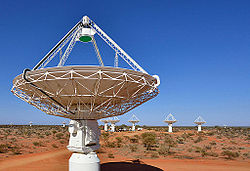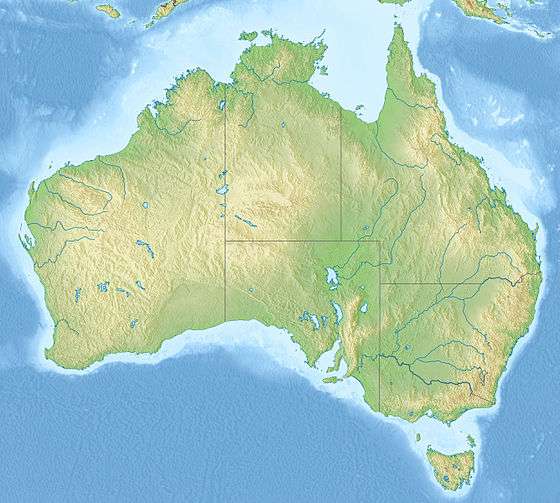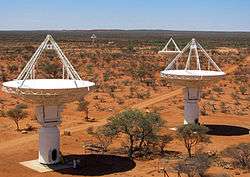Australian Square Kilometre Array Pathfinder
The Australian Square Kilometre Array Pathfinder (ASKAP) is a radio telescope array located at Murchison Radio-astronomy Observatory (MRO) in the Australian Mid West. It is operated by the Commonwealth Scientific and Industrial Research Organisation (CSIRO) and forms part of the Australia Telescope National Facility.[1] Construction commenced in late 2009 and first light was in October 2012.[2][3]
 Antennas of the ASKAP telescope at the Murchison Radio-astronomy Observatory in Western Australia | |
| Part of | Australia Telescope National Facility Murchison Radio-astronomy Observatory Square Kilometre Array |
|---|---|
| Location(s) | Western Australia, AUS |
| Coordinates | 26°41′46″S 116°38′13″E |
| Organization | CSIRO |
| Telescope style | radio interferometer |
| Website | www |
 Location of Australian Square Kilometre Array Pathfinder | |
ASKAP consists of 36 identical parabolic antennas, each 12 metres in diameter, working together as a single astronomical interferometer with a total collecting area of approximately 4,000 square metres. Each antenna is equipped with a phased-array feed, increasing the field of view. This design provides both fast survey speed and high sensitivity.
The facility began as a technology demonstrator for the international Square Kilometre Array (SKA), a planned radio telescope which will be larger and more sensitive.[4] The ASKAP site has been selected as one of the SKA's two central locations.[5]
Description
Development and construction of ASKAP was led by CSIRO Astronomy and Space Science (CASS), in collaboration with scientists and engineers in The Netherlands, Canada and the US, as well as colleagues from Australian universities and industry partners in China.[2]
Design
| External video | |
|---|---|
The construction and assembly of the dishes was completed in June 2012.[6]
ASKAP was designed as a synoptic telescope with a wide field-of-view, large spectral bandwidth, fast survey speed, and a large number of simultaneous baselines.[7]
ASKAP is located in the Murchison district in Western Australia, a region that is extremely "radio-quiet" due to the low population density and resulting lack of radio interference (generated by human activity) that would otherwise interfere with weak astronomical signals.[8] The radio quiet location is recognised as a natural resource and protected by the Australian Commonwealth and Western Australia State Government through a range of regulatory measures.
Data from ASKAP are transmitted from the MRO to a supercomputer (acting as a radio correlator) at the Pawsey Supercomputing Centre in Perth.[9] The data are processed in near-real-time by a pipeline processor running purpose-built software.[10] All data are made publicly available after quality checks by the ten ASKAP Survey Science Teams.
Science

During ASKAP's first five years of operation, 75% of its observing time was used for large Survey Science Projects. ASKAP was intended to study the following topics:[11]
- Galaxy formation and gas evolution in the nearby Universe through extragalactic HI surveys
- Evolution, formation and population of galaxies across cosmic time via high resolution, continuum surveys
- Characterisation of the radio transient sky through detection and monitoring (including VLBI) of transient and variable sources, and
- Evolution of magnetic fields in galaxies over cosmic time through polarisation surveys.
Initial surveys
Ten ASKAP Survey Science Projects were selected to run in the first five years of operations.[12] They were:
Highest Priority
- EMU: Evolutionary Map of the Universe[13]
- WALLABY: Widefield ASKAP L-Band Legacy All-Sky Blind Survey[14]
Lower Priority
- COAST: Compact Objects with ASKAP: Surveys and Timing
- CRAFT: The Commensal Real-time ASKAP Fast Transients survey
- DINGO: Deep Investigations of Neutral Gas Origins[15]
- FLASH: The First Large Absorption Survey in HI[16]
- GASKAP: The Galactic ASKAP Spectral Line Survey[17]
- POSSUM: Polarization Sky Survey of the Universe's Magnetism[18]
- VAST: An ASKAP Survey for Variables and Slow Transients[19]
- VLBI: The High Resolution Components of ASKAP: Meeting the Long Baseline Specifications for the SKA
Discoveries
In May 2020, astronomers announced a measurement of the intergalactic medium using six fast radio bursts observed with ASKAP; their results confirm existing measurements of the missing baryon problem.[20][21]
Odd radio circles (ORCs) are a possible "new class of astronomical object" discovered at ASKAP.[22]
See also
| Wikimedia Commons has media related to Australian Square Kilometre Array Pathfinder. |
References
- "The Australia Telescope National Facility". CSIRO. Retrieved 13 April 2011.
- "ASKAP Fast Facts" (PDF). CSIRO. Retrieved 13 April 2011.
- Fingas, Jon (5 October 2012). "Australia Square Kilometre Array Pathfinder goes live as the world's quickest radio telescope". Engadget. Retrieved 7 October 2012.
- "SKA Factsheet for Journalists" (PDF). SKA Project Development Office (SPDO). Skatelescope.org. Retrieved 13 April 2011.
- "Report of the SKA Siting Options Working Group" (PDF). SKA Organisation. Skatelescope.org. 14 June 2012.
- "ASKAP News". Atnf.csiro.au. 18 June 2012. Retrieved 18 January 2013.
- "Murchison Radio-astronomy Observatory". CSIRO. Retrieved 13 April 2011.
- "World's biggest radio telescope, Square Kilometre Array". BBC Radio 4. Retrieved 13 April 2011.
- "Pawsey Centre". iVEC. 14 June 2012. Archived from the original on 7 March 2013.
- "ASKAP Science Update, Vol. 5" (PDF). CSIRO. Retrieved 13 April 2011.
- "ASKAP Science". CSIRO. Retrieved 8 November 2010.
- "CSIRO sets science path for new telescope". CSIRO. Archived from the original on 19 March 2011. Retrieved 13 April 2011.
- "EMU: Evolutionary Map of the Universe". Atnf.csiro.au. 7 November 2008. Retrieved 18 January 2013.
- "WALLABY – the ASKAP HI All-Sky Survey". Atnf.csiro.au. Retrieved 18 January 2013.
- "DINGO". Internal.physics.uwa.edu.au. Archived from the original on 7 June 2013. Retrieved 18 January 2013.
- "Sydney Institute for Astronomy – The University of Sydney". Physics.usyd.edu.au. 15 September 2011. Retrieved 18 January 2013.
- "GASKAP". Retrieved 18 January 2013.
- "ASKAP POSSUM – Home Page". Physics.usyd.edu.au. 24 August 2012. Archived from the original on 12 October 2016. Retrieved 18 January 2013.
- "VAST: Variables and Slow Transients: Main – Home Page browse". Physics.usyd.edu.au. Retrieved 18 January 2013.
- Slezak, Michael; Timms, Penny (27 May 2020). "Half the matter in the universe was missing. Australian scientists just found it". ABC News (on-line). Australian Broadcasting Corporation. Retrieved 27 May 2020.
- MacQuart, J.-P.; Prochaska, J. X.; McQuinn, M.; Bannister, K. W.; Bhandari, S.; Day, C. K.; Deller, A. T.; Ekers, R. D.; James, C. W.; Marnoch, L.; Osłowski, S.; Phillips, C.; Ryder, S. D.; Scott, D. R.; Shannon, R. M.; Tejos, N. (2020). "A census of baryons in the Universe from localized fast radio bursts". Nature. 581 (7809): 391–395. arXiv:2005.13161. Bibcode:2020Natur.581..391M. doi:10.1038/s41586-020-2300-2. PMID 32461651.
- Osborne, Hannah. "'Odd' Circles of Radio Waves Coming from Unknown Cosmic Source Discovered". Newsweek. Retrieved 10 July 2020.